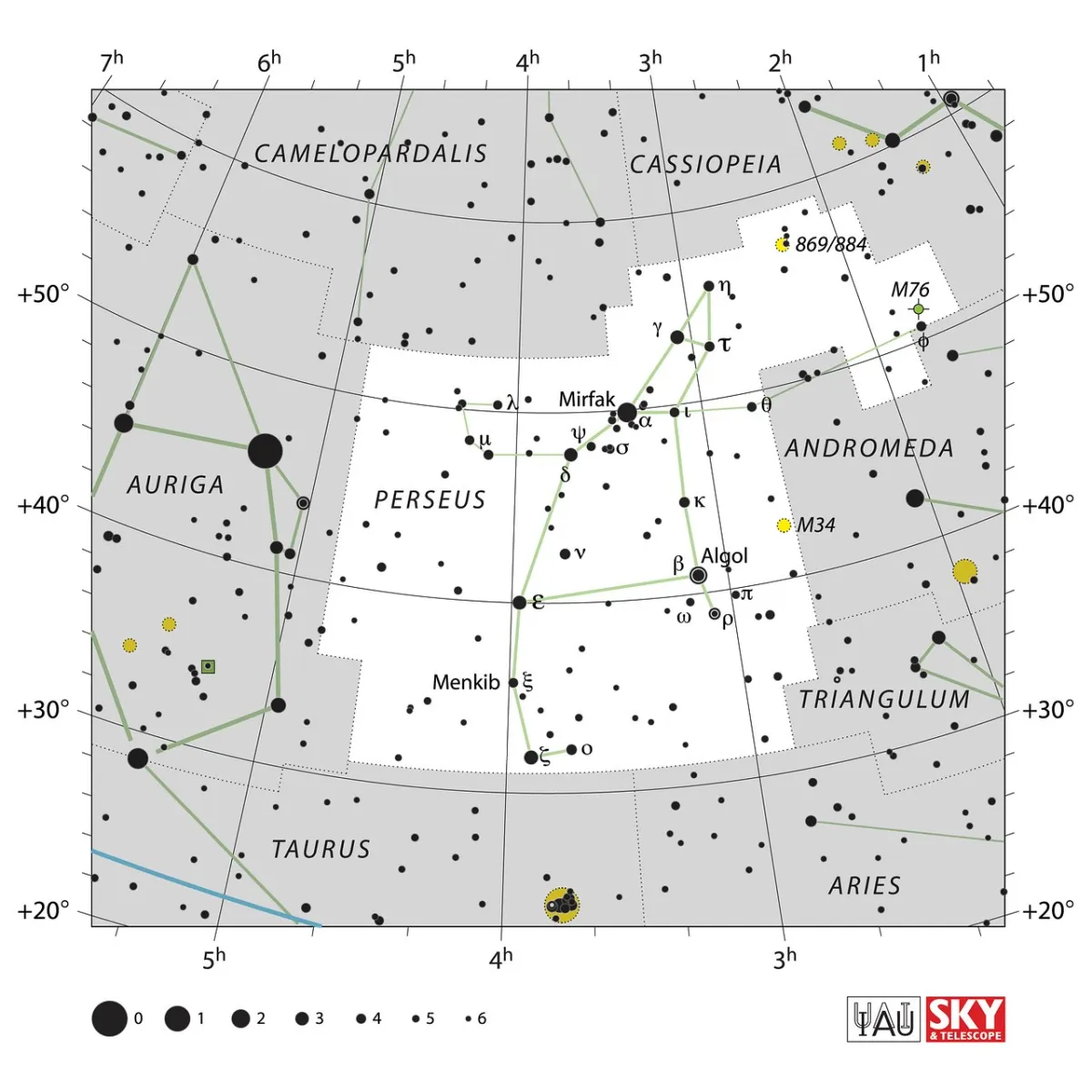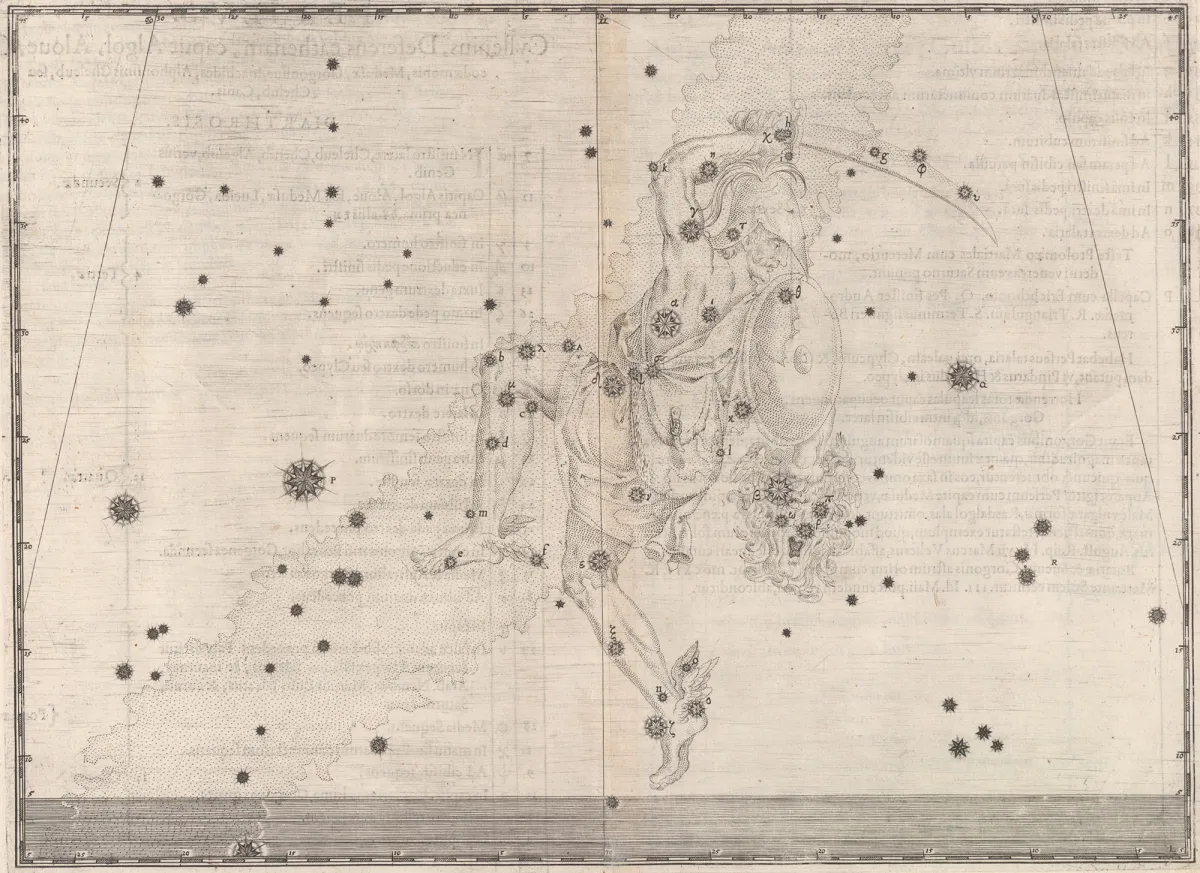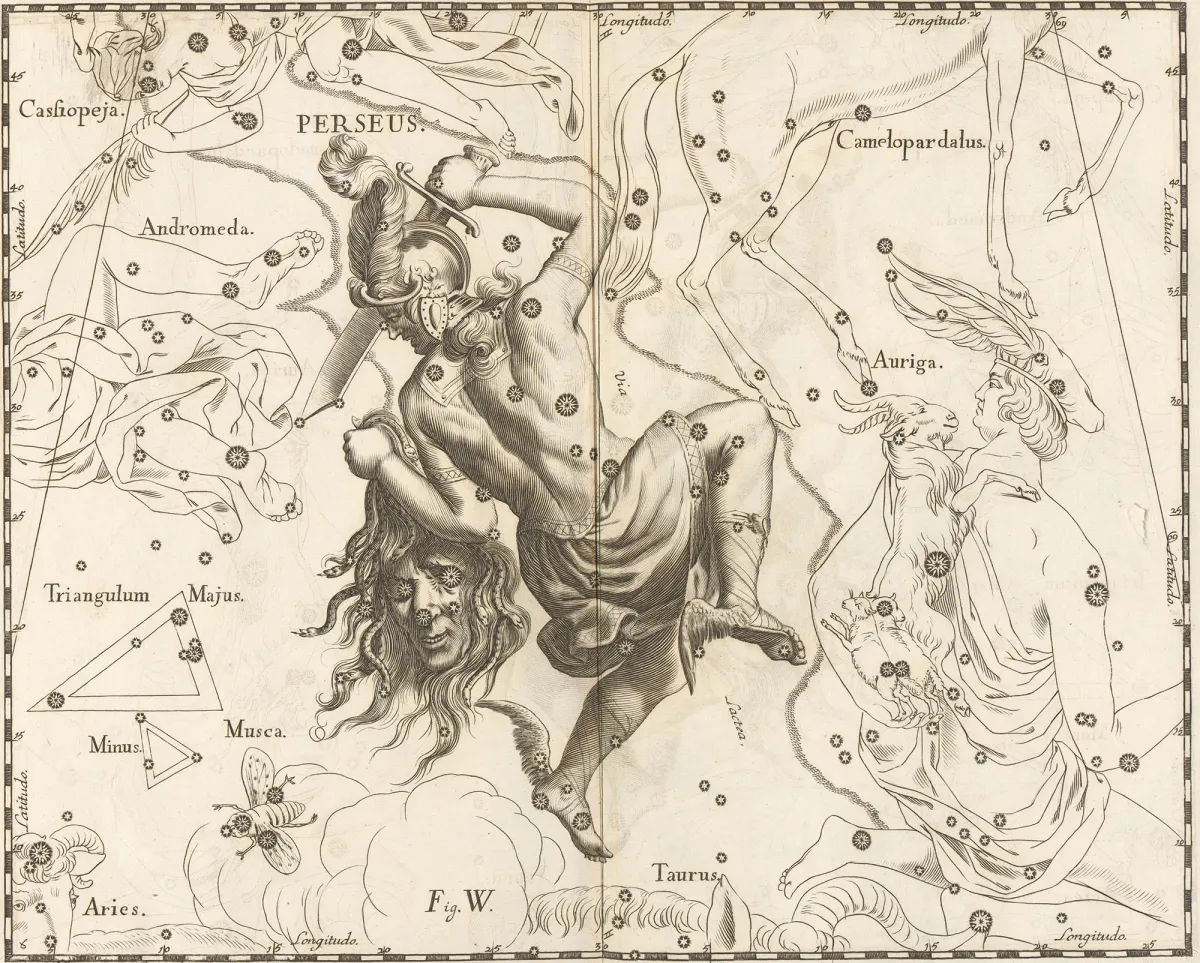Constellation Perseus (Hero)

Properties
Perseus lies east of Andromeda and southeast of Cassiopeia. The band of the Milky Way runs through this constellation and is darkened there by a large cloud of dust. Despite its glorious legend, Perseus is a figuratively difficult to understand constellation. The most striking is the small, elongated group of stars around Algenib. To the south of this is the bright, short-period variable star Algol, which is therefore also called devil's eye and represents the severed Medusa head. The area of the constellation is 615 square degrees and the centre culminates around midnight on November 7th. [9, 15]
| α Per | Mirphak, Mirfak, Marfak, Algenib |
| β Per | Algol, Gorgona, Gorgonea Prima, Demon Star, El Ghoul |
| η Per | Miram |
| ξ Per | Menkib, Menkhib, Menchib |
| ο Per | Atik, Ati, Al Atik |
| π Per | Gorgonea Secunda |
| ρ Per | Gorgonea Tertia |
| ω Per | Gorgonea Quarta |
| IAU Name | Perseus |
| IAU Genitive | Persei |
| IAU Abbr. | Per |
| English Name | Hero |
| Culmination at local midnight | 18 November |
| Season (Latitude +0.0°) | July … April |
| Right Ascension (J2000.0) | 01h 29m 38s … 04h 51m 22s |
| Declination (J2000.0) | +30° 55' 19" … +59° 06' 17" |
| Area | 615 deg2 |
| Neighbours (N↻) | Cas, And, Tri, Ari, Tau, Aur, Cam |
Deep-Sky Object Descriptions
Messier 76
NGC 869/884
NGC 1275
NGC 1333
NGC 1342
NGC 1491
NGC 1499
NGC 1513
NGC 1579
Catalogues
Mythology and History
Akrisios was the king of Argos and had a lovely daughter named Danae. The Oracle of Delphi prophesied that his grandson would one day kill him. For fear of this oracle, Akrisios had his daughter Danae locked in a tower so that she could not receive a husband. Of course, Akrisios could not have known that Zeus himself wanted to approach the lovely Danae. Zeus did this too and took the form of a golden rain that penetrated through the walls, joints, cracks and windows. Danae gave birth to a son, who was called "The one who emerged from flowing gold" or "The one who was born in gold" - Perseus. Akrisios didn’t keep this hidden for long, of course, and had his daughter and grandchild nailed into a box, which was then thrown into the sea.

Danae and Perseus drifted for a long time until they finally stranded on the coast of the stony island of Seriphos and were freed from their prison. On this island, Polydektes ruled, who soon campaigned for the beautiful Danae for years, but in vain. Either to force Danae into marriage after all, or to get Perseus out of the way, he sent Danae's son, who had meanwhile grown into a youth, to do a deadly task. He should get the head of Medusa.
Medusa was one of the Gorgons, one of the three daughters of Phorkys, who were equipped with snake hair and could cast a petrifying look. Two of these daughters were immortal, while Medusa was mortal. This father also had three other daughters, the Graien, "the ancient ones", who all together had only one eye and one tooth, which they had to borrow alternately if needed.
With the help of Hermes' winged shoes, the hat of Hades, which spread the impenetrable night, and the sickle sword of the limping fire and blacksmith god Hephaestus, Perseus succeeded in overcoming the Graien. He took away their only eye when the second of the three sisters wanted to see something. The way was cleared and he penetrated the Gorgons with the Hades cap pulled over his head. Perseus was careful not to look directly at Medusa, but only to look at her reflection in his polished shield - otherwise he would have immediately turned to stone. In this way he managed to behead Medusa, who was pregnant by Poseidon. The winged horse Pegasus then rose from the dead body. Even the grown-up warrior Chrysaor with a golden sword in hand emerged from her dead body. Perseus put the Gorgon head, which was still dripping with blood, into the magic sack and escaped with the help of the Hades cap, which spread deep darkness all around.

Perseus passed the coast of Ethiopia on his way back. There was the beautiful Andromeda - the daughter of the queen Kassiopeia and the king Kepheus - helpless and almost naked, only wearing a few pieces of jewelry, chained to a rock. A dreadful sea monster approached her with the intention of devouring her. Perseus immediately fell in love with the beautiful princess. He seized the opportunity and asked Andromedas father, King Cepheus of Ethiopia, that Hand of his daughter and a kingdom of her own to save her. He agreed, fearing for his daughter's life. Then Perseus put on his winged shoes and hurried through the air in the direction of sea monsters. Everything he did was designed to get this girl's attention to himself. The liberation took place only armed with the sword. [20] More common, however, is the variant in which he took Medusa's head out of the sack and petrified the sea monster into a rock in the sea. [66]
Perseus hurried back to his home island Seriphos and appeared in front of Polydectes. He shouted: "Here is your present!" and held up Medusa's head. Instantly the king and his followers froze to stone. Perseus returned to his lover Andromeda and married her. Both lived long and happily and had many children. One of her great-grandchildren was Hercules. When Perseus died, he was granted a place under the stars in the sky: his sword stretched up and the diabolical head of Medusa held in the other hand, so that she might look upon humanity for all time. [66]
Some names like Perseus, Perseus et Caput Medusae, Victor Gorgonei monstri, Gorgonifer are reminiscent of the story and Bearer of Medusa Head. This star formation was also transformed into biblically oriented images such as David with the head of Goliath and Apostle Paul with sword and book. [20]